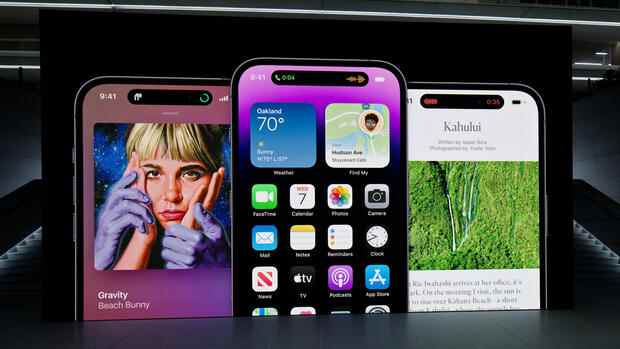Stronger performance, brighter display and longer battery life.
(Photo: via REUTERS)
san francisco Until now, SIM cards have been one of the essential components of mobile phones. The most valuable technology group Apple is now taking a radical step to change that: For the first time, the company is completely omitting the slot for physical SIM cards in the latest iPhone devices.
In the USA, the devices of the latest generation of iPhones 14 would only support electronic SIM cards, so-called eSIM, announced the responsible Apple product manager Kaiann Drance on Wednesday at the Apple company headquarters in Cupertino, California.
It has been technically possible to use smartphones without physical SIM cards since 2016. To do this, both the network operator and the end device must support eSIM. Samsung introduced the first smartphone with this function in 2016.
Apple also supports the eSIM function with the iPhones of the 13th generation. At the same time, however, the end devices retained the option of using physical SIM cards.
Top jobs of the day
Find the best jobs now and
be notified by email.
Apple is now changing that. “For the first time, all models sold in the US will no longer have a SIM card slot,” announced Drance. “As a result, it is no longer necessary to deal with physical SIM cards,” said the product manager. The iPhones could store multiple eSIMs and thus multiple phone numbers in parallel, Drance said.
In Germany, all three network operators support eSIM technology. Both Deutsche Telekom, Vodafone and Telefónica offer solutions. This eliminates the need to send physical cards for new contracts. However, users keep complaining that changing an eSIM to another device is more difficult. Not all modern smartphones support eSIM.
And the network operators often have to go through a process to send a digital eSIM for another device. How Apple intends to solve these problems was initially left open by Drance. Wedbush analyst Daniel Ives welcomed Apple’s focus on eSIM, emphasizing that the approach could help protect devices from misuse.
With the iPhones of the 14th generation, emergency SMS can be sent via satellite.
(Photo: REUTERS)
In addition to stronger performance, a brighter display and longer battery life, Apple introduced a new communication technology with the iPhone 14 for the first time. The devices can also send messages via satellite without cellphone reception. With a direct view of the sky, emergency messages can also be sent to rescue workers in dead spots, Apple announced.
However, the connection remains a technical challenge, as the group emphasized at the presentation on Wednesday. The iPhone must be aimed directly at the satellite, and the transmission can take a few seconds or several minutes. Since the satellites are not visible to the naked eye, users get help aligning the devices with an on-screen graphic.
The feature will initially only be available in the US and Canada and will be free for iPhone 14 buyers for the first two years.
It was the first major novelty event on-site since the pandemic began.
(Photo: Reuters)
The more expensive Pro models of the iPhone 14 get, among other things, a smaller section on the display for the selfie camera and face recognition. The screen can also stay on all the time.
The prices for the iPhone 14 Pro now start at 1299 euros instead of 1149 euros previously. The larger Pro Max now costs at least 1449 euros instead of the previous 1249 euros. The basic model of the iPhone 14 costs 999 euros compared to 899 euros for the iPhone 13.
The launch of the iPhone 14 was Apple’s first major on-site novelty event since the pandemic began. In the past two years, new iPhones have only been presented online. Once again, after a short welcome by CEO Tim Cook, the presentation was played to those present as well as to the viewers at home as a video.
The iPhone is by far Apple’s most important product. Sales of the device bring in around half of the group’s revenues. It also plays a key role in sales of other devices like watches and earbuds, as well as services like Apple Music.
Suitable for divers – the new Apple Watch.
(Photo: via REUTERS)
Apple also introduced a new smartwatch called the Apple Watch Ultra, which, among other things, should have the full functionality of a diving computer. Thanks to a larger battery, the Watch Ultra is said to run for 36 hours without charging – and up to 60 hours with activated power saving settings. All versions of the watch come with a built-in cellular connection by default.
An additional large button should also be easy to operate with gloves, which helps divers, for example. With a price of $799 in the US, the Ultra watch is slightly more expensive than previous models.
The conventional new Apple Watch 8 gets two sensors that measure body temperature. New motion sensors can detect car accidents so the watch can automatically alert emergency services. The watch recognizes, among other things, a frontal or side impact as well as a rollover. The watch also evaluates the ambient noise.
Apple has been at the forefront of the computer watch business since the release of the first Apple Watch in early 2015. According to calculations by the analysis company Canalys, Apple sold 18 million watches in the first half of the year and thus had a market share of 52 percent.
With material from agencies.
More: How Apple wants to become less dependent on China with the iPhone 14
